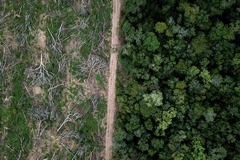Carbon markets overlook shade-grown coffee farms’ climate potential, study reveals
Markets are undervaluing the carbon storage potential of mature shade trees on coffee farms, a study by US-based Smithsonian’s National Zoo and Conservation Biology Institute (NZCBI) and the Smithsonian Tropical Research Institute (STRI) reveals.
The researchers found that these existing shade trees store more carbon than newly planted trees, yet carbon markets only reward tree planting, not the preservation of mature trees. This oversight may hinder efforts to combat climate change by encouraging the removal of the very trees that store the most carbon.
“There is a lot of money behind planting trees on degraded coffee farms, yet there are basically no financial incentives, outside of the Smithsonian Bird Friendly certification, to protect standing shade trees,” says Ruth Bennett, senior author of the study and an ecologist at NZCBI.
“To be clear, planting shade trees on monoculture coffee farms is a positive step, but our findings show tree planting alone can’t make up for what you lose when you remove mature shade trees.”
The study examined data from 67 scientific studies worldwide and modeled various scenarios. It found that if all sun-grown coffee farms planted shade trees, they would sequester an additional 82 to 87 million metric tons of carbon. Meanwhile, converting shade-grown coffee to monocultures could release between 174 and 221 million metric tons of carbon.

“If we don’t prioritize biodiversity on carbon sequestration projects, it won’t accidentally happen. “This means choosing a diverse suite of shade trees with the aim of conserving biodiversity,” says Emily Pappo, the study’s first author and a postdoctoral climate fellow at the Smithsonian.
The study is published in Communications Earth & Environment.
Need for variety
The team also found that carbon-focused tree planting often prioritizes tree density over biodiversity. While increasing tree density may boost carbon capture, biodiversity thrives when various tree species are planted.
 The scientists urge coffee companies to focus on planting a diversity of shade trees to enhance biodiversity (Image credit: Roshan Patel, NZCBI).“To protect nature and fight climate change, coffee companies need to focus on planting a diversity of the right trees, not just planting a high density of fast-growing trees that capture carbon,” notes Pappo.
The scientists urge coffee companies to focus on planting a diversity of shade trees to enhance biodiversity (Image credit: Roshan Patel, NZCBI).“To protect nature and fight climate change, coffee companies need to focus on planting a diversity of the right trees, not just planting a high density of fast-growing trees that capture carbon,” notes Pappo.
Coffee farms that maintain a variety of shade trees are also better for biodiversity. Farms with diverse tree cover host up to four times as many bird species as monoculture farms.
The Smithsonian Bird Friendly certification promotes farms that conserve high-quality wildlife habitat and rewards farmers for maintaining diverse shade tree cover. This allows them to sell their coffee at premium prices.
Despite these benefits, coffee farmers are under increasing economic pressure due to climate change, leading some to remove shade trees to increase coffee production. While removing shade trees may initially seem beneficial for yields, these trees also help regulate temperature and moisture, providing long-term benefits for farmers.
Call for carbon market evolution
The researchers argue that current carbon markets need to evolve. They recommend creating carbon payment programs that reward the preservation of existing shade trees and prioritizing tree diversity in tree-planting initiatives. Without these changes, investments in tree planting may fall short of their climate goals.
Moving forward, Smithsonian researchers are developing resources like the Shade Catalog to help farmers select trees that balance carbon storage, biodiversity, and farm productivity. Bird Friendly-affiliated researchers are also working on tools to help farmers balance carbon storage, biodiversity, and farm productivity.













